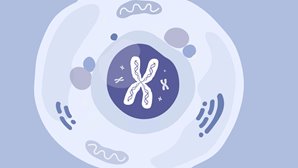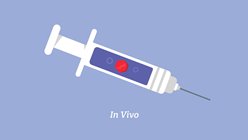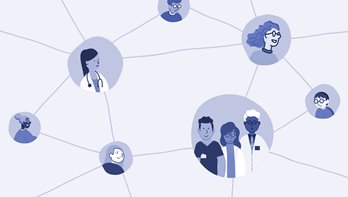Getting to Know Genes
Most of our body’s genetic information is stored in 23 paired chromosomes inside the nucleus of our cells. Each chromosome is made up of DNA that stores information to determine our unique characteristics. Specific sections of DNA are called genes. Each person typically gets two copies of each gene from their biological parents. These genes control everything from hair color, to height, to many other traits. As far as we know, humans have between 20,000 and 25,000 genes.
When Genes Change
 Genes are the blueprints providing instructions on how to make proteins for the body. Proteins play an important role in how our body functions. Unfortunately, these blueprints are not always correct. A gene variant, also known as a gene mutation, is a small change to the DNA within our genes that can alter the instructions for how proteins are built and work. This can then affect how a person breathes, walks, or digests food. Gene changes can be inherited (passed along from parents), can happen as we age, or can be caused by environmental factors (chemicals and radiation). These genetic changes happen to everyone but sometimes there can be rare changes that cause disease by altering how specific proteins function.
Genes are the blueprints providing instructions on how to make proteins for the body. Proteins play an important role in how our body functions. Unfortunately, these blueprints are not always correct. A gene variant, also known as a gene mutation, is a small change to the DNA within our genes that can alter the instructions for how proteins are built and work. This can then affect how a person breathes, walks, or digests food. Gene changes can be inherited (passed along from parents), can happen as we age, or can be caused by environmental factors (chemicals and radiation). These genetic changes happen to everyone but sometimes there can be rare changes that cause disease by altering how specific proteins function.
How Gene Therapy Works
 Gene therapy aims to address the underlying cause of disease, such as changes in our genes. If genes are like the blueprint to our body, gene therapy can fill in missing parts or correct errors in the drawings.
Gene therapy aims to address the underlying cause of disease, such as changes in our genes. If genes are like the blueprint to our body, gene therapy can fill in missing parts or correct errors in the drawings.
Gene therapy is the use of genetic material to treat or prevent disease. The genetic material that is delivered, DNA or RNA, has instructions to change how a protein—or group of proteins—is produced by the cell. For some diseases, this means making changes to account for too much, not enough, or incorrect essential proteins being produced within cells.
This new genetic material, such as a working gene, is delivered into the cell using a vector. A vector is like a package used to deliver a specific message. Viruses can be used as vectors because they have evolved to be very good at getting into cells. Scientists have learned how to remove the viral genes and use this same ability to treat or prevent disease. In this case, their goal is to insert the new genetic material into the cell. All viral vectors are tested many times for safety prior to being used in humans.
The vector can be delivered in one of two ways:
-
ex-vivo treatment removes the person’s own cells and delivers the genetic material to these cells outside the body. The modified cells are then returned to the body.
-
in-vivo treatment means the genetic material is delivered
directly into the person, such as through an injection.
Learn more about gene therapy approaches.
Potential, Challenges, & Risks of Gene Therapy
Potential
-
Hope for fatal disease. Gene and cell therapy can help treat diseases that have limited treatment options. Without treatment many of these inherited disorders would end in severe disability or premature death. But with gene and cell therapy, early studies show that these disorders have been slowed or completely stopped.
-
Earlier can be better. If gene therapy is received earlier in the course of disease, it has the potential to stop any damage before it occurs. It is still being researched to what extent a gene therapy might reverse any damage.
-
Targets the cause. Gene and cell therapies make it possible to design treatments that can target any of the thousands of genes in the body.

Challenges
-
Time. It is a lengthy process, often many years, to test potential treatments in clinical trials and undergo the FDA approval process. It may also take time to find a diagnosis for a particular gene variation causing disease symptoms.
-
Not one-size-fits all. Each disease with a certain gene variation requires a specific gene therapy approach. Currently, most gene and cell therapy options are limited to treating only the disorders that are caused by variations in a single gene. People may have changes in different genes but still have the same disease. In this situation, they would likely need different gene therapy approaches each targeted to their gene variation. Work is being done by to develop platforms and standards that will speed the development and delivery of customized gene therapies. One example is the Bespoke Gene Therapy Consortium, among many others.
-
 Small number of participants. Gene therapy often targets rare diseases, meaning there is a small number of people with the disease. This means it can take longer or be more difficult to gather enough research data on potential treatments or to find enough people that are eligible to participate in a clinical trial. Although each disease may be rare, rare diseases combined affect an estimated 400 million people. There are numerous hard-working patient advocacy groups and foundations working to fund and move research along in this space.
Small number of participants. Gene therapy often targets rare diseases, meaning there is a small number of people with the disease. This means it can take longer or be more difficult to gather enough research data on potential treatments or to find enough people that are eligible to participate in a clinical trial. Although each disease may be rare, rare diseases combined affect an estimated 400 million people. There are numerous hard-working patient advocacy groups and foundations working to fund and move research along in this space.
-
Funding. There are high costs that go into the work it takes to prepare a clinical trial, make a gene therapy, and ensure it is carried out at the highest standard and ensuring safety for participants.
-
Accuracy required. Gene and cell therapies need to express the gene in the right tissue, at the right level, for the right amount of time. This means that a lot of research goes into the best way to deliver the genetic material. The response of the person’s immune system also needs to be considered based on the therapy.
Learn more about the clinical trials process.
Risks
-
Informed consent. Before participating in a clinical trial, a member of the research team should review any potential risks and benefits with the participant and/or caregiver. It is important that participants understand their rights during the research process and know what to expect.
-
No guarantees. Therapies being studied in clinical trials are not a guaranteed cure and cannot guarantee beneficial results. There is always a chance that the investigational treatment may not work or may have unexpected side effects.
-
Repeat administration.The delivery of foreign material to the body can cause an immune response and may exclude patients from receiving later treatments. Participating in a clinical trial may also prevent future participation in other trials or from additional types of treatments. This includes if a better therapy is developed later on.
-
Long-term effects unknown. Gene therapy can be an alteration for a lifetime, so people should be aware that there could be long term effects (both good or bad) that are unknown at this time. That is why gene therapies are monitored in a person for years following treatment.
Next, visit Gene Therapy Approaches to learn more about the different types of gene and cell therapy.
Was this information helpful? If so, please share! All ASGCT Patient Education resources are free to use by sharing on social media, embedding the video, or simply linking to this page! A full media kit is available here. Please credit the American Society of Gene and Cell Therapy or tag @ASGCTherapy.